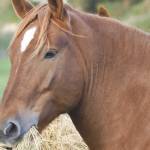Algae for Equine Metabolic Syndrome: A Possibility?

Equine metabolic syndrome (EMS) continues to be an important health and welfare issue throughout the industry. New research* shows that “algal biomass” may be an up-and-coming nutritional strategy that could help prevent or treat EMS.
“While breed is certainly a contributor to EMS, with certain horse and pony breeds more likely to develop EMS, diet plays a huge role in the disease process,” explained Kathleen Crandell, Ph.D., a nutritionist for Kentucky Equine Research.
Susceptible horses fed a diet abundant in nonstructural carbohydrates (NSC), including sweet feeds and high-starch concentrates,in excess of their requirements can become overweight. Nonstructural carbohydrates include simple sugars like glucose, fructose, and lactose as well as starches that are rich in calories and easily digested.
High levels of circulating glucose from NSC stimulate the pancreas to secrete excessive insulin, ultimately leading to the development of insulin resistance or possibly laminitis in at-risk horses. In contrast, forages have lower levels of NSC, which are destined to be fermented in the hindgut to produce volatile fatty acids for energy.
“Concentrates or other feeds richer in nonstructural carbohydrates than forage are not undesirable for all horses. In fact, many horses need nonstructural carbohydrates to perform their best. We are simply pointing out that not all horses require these products in their diets,” emphasized Crandell. “Horses need to be fed on a ‘personal’ level to properly address individual dietary requirements.”
A new trend in feed science involves algal biomass. Algae are rich in protein, polyunsaturated fatty acids, polysaccharides, fiber, minerals, and vitamins, and algae can be processed to produce feeds for various livestock and other animals, even humans.
“Our own research has indicated that horses fed a diet based on Spirulina platensis supplementation lost weight and improved insulin sensitivity,” shared the researchers involved in the new study. With this is mind, they proposed that algal biomass should be considered a possible source of nutrients in feeding EMS horses.
Widespread use of algae as a feedstuff for horses might be years away despite the current research. “When choosing any feedstuff for horses, it is best to thoroughly review any unusual ingredients, looking specifically for research proving its efficacy and safety,” said Crandell.
In managing horses with EMS, ensure they maintain an appropriate body condition score to help minimize insulin dysregulation and laminitis. Coupled with moderate weight, exercise can help keep metabolic disorders at bay. Sound horses with a tendency to gain weight should have exercise added to their daily schedules.
To best assess your horse’s personalized dietary needs, contact a KER nutritionist today.
*Krzysztof Marycz, K., I. Michalakc, K. Kornicka. 2018. Advanced nutritional and stem cells approaches to prevent equine metabolic syndrome. Research in Veterinary Science 118:115-125.








